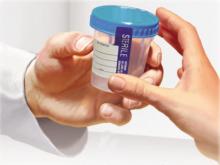• When you initiate opioid therapy for chronic pain, inform the patient that routine monitoring includes random urine drug testing (UDT). C
• Consider UDT not only for patients at high risk for abuse of prescription opioids, but for lower-risk individuals receiving opioid therapy, as well. C
• Use caution in interpreting the results of UDT; testing cannot reliably detect some opioids, and a negative result is not necessarily an indication of noncompliance. C
Strength of recommendation (SOR)
A Good-quality patient-oriented evidence
B Inconsistent or limited-quality patient-oriented evidence
C Consensus, usual practice, opinion, disease-oriented evidence, case series
CASE 1 Marilyn H, a 54-year-old woman with multiple chronic conditions, visits a “new” primary care physician to establish care following the retirement of her previous physician. She has poorly controlled diabetes, hypertension, and a lung nodule recently noted on a chest radiograph. Marilyn requests prescriptions for hydrocodone and alprazolam, stating that she has taken both drugs for years for chronic back pain and anxiety.
CASE 2 Don F, 38, has been on oxycodone/acetaminophen (Percocet) for 3 years for back pain resulting from a car accident. He has a remote history of amphetamine abuse, but reports that he has been clean for 10 years. Since the initiation of his pain medication, there have been no problems, and no “lost” prescriptions or requests for early refills.
If you were Marilyn and Don’s physician, would you order urine drug testing (UDT)?
Management of opioid therapy is a challenge for many family physicians, particularly when treating noncancer pain. Seemingly contradictory messages from various medical associations are part of the problem. Organizations such as the Joint Commission on Accreditation of Healthcare Organizations and the American Medical Association emphasize the importance of appropriate pain management, while regulatory bodies like the US Drug Enforcement Agency and many state medical boards warn of inappropriate prescribing and diversion of controlled substances.1-4
In the realm of opioid management guidelines, however, patient monitoring is a common theme. It’s not hard to understand why. The Centers for Disease Control and Prevention reports that, between 1999 and 2005, the incidence of unintentional drug overdose more than doubled—a consequence of increasing abuse of prescription opioid analgesics.5 Prescription medications are now the second most commonly abused drug category (marijuana is first6), accounting for more cases of abuse than heroin, cocaine, and hallucinogens combined.7 In primary care and pain management settings, estimates are that more than 1 in 4 chronic pain patients misuse opioids or illicit drugs.8
Thus, physicians who prescribe controlled substances face increasing pressure to prevent opioid diversion. That pressure is reflected in the US Federation of State Medical Boards (FSMB)’s Model Policy for the Use of Controlled Substances for the Treatment of Pain, which was updated in 2004.4 This policy underscores physicians’ responsibility to closely monitor patients being treated with opioids for chronic pain.
Inexpensive and noninvasive. To this end, UDT can be a valuable tool. It is the most widely used and acceptable form of drug testing, because it is inexpensive and noninvasive, and because most drugs can be detected in urine for 1 to 3 days.9,10 But many primary care physicians are unfamiliar with the complexities of UDT, and often fail to use it.11 One study found that only 8% of family physicians employed UDT for patients on chronic opioid therapy.12
When introduced and used appropriately, UDT can not only help detect misuse of controlled substances, but may strengthen the doctor-patient relationship, as well. For that to happen, however, the physician who orders urine testing must know which patients to test, when to test, and what urine testing can (and cannot) reveal.
Consider testing all patients treated for chronic pain
The FSMB urges physicians to consider a written agreement with any patient receiving chronic opioid therapy who has a history of, or is at high risk for, substance abuse.4 (Red flags are listed in TABLE 1.13-15) The document should state that the patient is responsible for providing urine and serum specimens for drug monitoring upon request. The 2009 guidelines from the American Pain Society and the American Academy of Pain Medicine also address the role of drug monitoring, strongly recommending periodic urine screens for high-risk patients on chronic opioid therapy.16
Evidence suggests that predictors of aberrant behavior are not completely reliable, however, and that a substantial number of individuals using illicit substances will be missed if clinicians restrict urine testing to those they deem to be at high risk.17 Thus, UDT may be a valuable tool for low-risk patients on chronic opioid therapy, as well. Written agreements governing opioid therapy may also be useful for low-risk patients.


